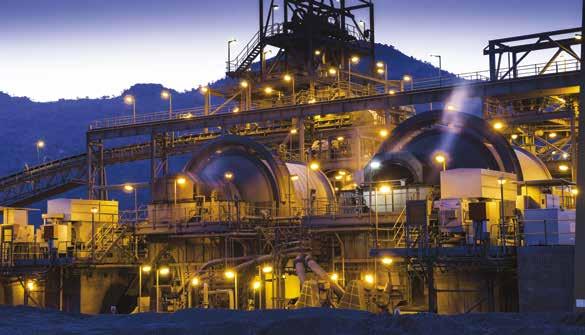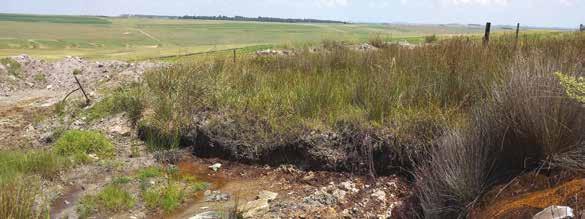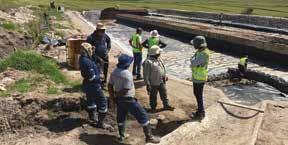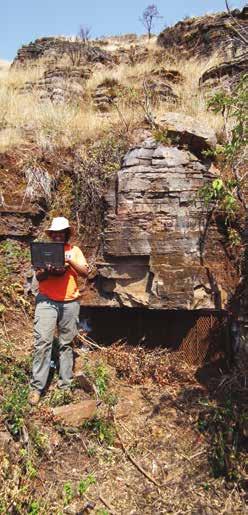
14 minute read
Mining
The revival of Matla coal mine will cost R3.3-billion.
Mining contributes 25.9% of the province’s gross domestic product and employs more than 53 000 people. Expansion projects by several miners are underway, including South32, Exxaro Resources, Pan African Resources and Canyon Coal.
Mpumalanga accounts for 83% of South Africa’s coal production and is the third-largest coal-exporting region in the world. Although renewable energy is catching on in South Africa, there is no prospect of Mpumalanga’s coal-fired power stations being mothballed soon.
National utility Eskom will spend R3.3-billion on the revival of the Matla coal mine. The mine was put on care and maintenance in 2016 but expectations are that it should be able to produce more than 10-million tons per annum by the second half of 2024. Exxaro Resources will manage the project and do the mining while major companies such as DRA, Worley, Sandvik and WBHO will also be involved.
Other companies engaged in expansion of life-of-mine projects are Pan African Resources and Evander (Elikhulu tailings), Exxaro Resources (Leeuwpan) and South32, which is spending about R4.3-billion at Klipspruit.
Menar, which has several operations in Mpumalanga via Canyon Coal and Kangra, will spend about R600-million the first phase of its De Wittekrans asset near Hendrina, the open-cast operation. The second phase would entail going underground to dig for coal. Kangra intends reopening the Savmore/Maquasa coal mine which was closed because of the global lockdown in 2020.
The sod-turning ceremony of another new mine at Mabola in the Wakkerstroom area was supposed to happen in March 2021, but an urgent court order put a stop to Uthaka Energy’s plans. Environmentalists have argued that the province should not have revoked the area’s protected status as important wetlands stand to be affected. The multi-year legal battle looks set to contiue. Uthaka Energy was previously known as AthaAfrica Ventures, a local subsidiary of the India-based Atha Group.
Arnot coal mine has signed a contract for underground mining services with Boipelo Mining Contractors worth R3.2-billion. Boipelo comprises Middelburg-based Amandla TM (51%) and Murray & Roberts Cementation (49%).
South32 sold its South African Energy Coal (SAEC) business to black-owned Seriti
Credit: Implats
SECTOR INSIGHT A court order has stopped a proposed new coal mine in the Wakkerstroom area.
Resources in 2019 but in 2021 also agreed to make $250-million available to enable Seriti to restructure some of the coal assets and to rehabilitate others.
Afrimat is listed on the JSE in the “Construction and Building Materials” section, but the company has shown an appetite for acquiring mines in order to diversify.
In May 2020 Afrimat made a bid for control of Unicorn Capital Partners (previously Sentula Mining) which controls the Nkomati Anthracite mine in Mpumalanga. The mine, which is in the southeastern corner of the province, has proven resources of 8.7-million tons and upwards of 400 jobs were created over the last two years. Local communities have a 16.1% stake in the re-launched mine and the Mpumalanga Economic Growth Agency (MEGA) holds 34%.
Platinum
Platinum is an important mineral for the modern economy. Two Rivers is a joint venture between Implats (46%) and African Rainbow Minerals which is located on the southern part of the eastern limb of the Bushveld Igneous Complex, 35km south-west of Burgersfort in Mpumalanga.
Northam Platinum, which has assets on both limbs of the Bushveld Igneous Complex, has purchased the Everest mine from Aquarius Platinum. Everest is adjacent to Northam’s existing Booysendal mine.
Jubilee Platinum has sold its Smelting and Refining business in Middelburg to Siyanda Resources. Sylvania Platinum now has seven PGM recovery plants that extract chrome from tailings on both sides of the Bushveld Igneous Complex.
Lydenburg is home to the Lion ferrochrome smelter that is a joint venture between Glencore and Merafe Resources. Assmang, the joint venture between ARM Ferrous and the JSE-listed Assore, operates a chrome mine (Dwarsrivier) and a ferrochrome plant where chrome alloys are made.
Training
Most of the province’s mining companies are involved in training. The Colliery Training College (CTC) in Emalahleni is owned by a consortium of companies: Exxaro, Glencore, Kangra Coal, South32 and Izimbiwa Coal. The centre offers a broad range of artisan training, including auto electrician, fitting and turning and millwrights. CTC has been recognised as a leader in artisan training by the National Skills Authority.
Coal giant Exxaro, which runs five mines in the province, has committed R3.8-billion to its Belfast project, an investment that will create 1 160 jobs and have an impact on the GDP (over the life of the mine) of R39-billion.
After Exxaro Coal Mpumalanga’s transfer of its 50% stake in the Arnot coal mine to mineworkers at no cost, the workers received a further 5% “free-carry” because of the specifications of Mining Charter III. The mine thus becomes South Africa’s first majority workerowned mine. Wescoal is the other shareholder and operator of the mine.
The opening in April 2019 of Sasol’s Impumelelo Colliery south-west of Secunda was the final phase of an investment in new coal mines to replace three coal mines that had reached the end of their lives. Sasol produces 40-million tons of coal annually. Impumelelo, which will produce 8.5-million tons per year, cost R5.6-billion to build.
State coal company AEMFC (African Exploration Mining & Finance Corporation) runs a colliery at Vlakfontein near Ogies and is planning to develop other projects. South32 has four collieries and three processing plants in the province. ■
ONLINE RESOURCES
Colliery Training College: www.ctctraining.org Minerals Council South Africa: www.mineralscouncil.org.za National Department of Mineral Resources: www.dmr.gov.za South African Institute of Mining and Metallurgy: www.saimm.co.za
Finding new ways of reducing and reusing carbon
Council for Geoscience CEO, Mosa Mabuza, is excited about new research on carbon capture and is intent on expanding his organisation’s relevance to the South African economy.
Mosa Mabuza, CEO
BIOGRAPHY
After qualifying as a geologist from Wits University, Mosa held various positions at De Beers and Anglo American and worked in jurisdictions as varied as West Africa and Canada. From his appointment as the Director of Mineral Economics in the former Department of Minerals and Energy, he was promoted to Deputy Director-General of Mineral Policies and (Investment) Promotion in 2012. He has been CEO of CGS since 2017. How will the Council for Geoscience (CGS) carbon capture and the storage project in Mpumalanga expand South Africa’s energy mix and decrease the country’s carbon footprint? We abbreviated the project to CCUS: Carbon Capture for the two Cs, U for utilisation, storage as the last stage. Once the carbon is captured it has numerous applications. Not only would you be able to reduce the carbon content that is emitted into our climate, but you can also apply it in fertiliser manufacturing and in a number of other applications.
We see it as a scientific intervention that gets us as a country to breathe life into the climate mitigation measures, in terms of the international climate protocol that we have committed to. If the science is proven, not only will South Africa meet but it will go far beyond the minimum commitments that we have made as a country.
But we’ve got to let the science take place, we’ve got to let the pilot project prove that indeed, it is a sensible scientific intervention, that the economics make sense, that science and the intentions are met. Only once we have proven all of those three attributes, would we be confident enough to say that, indeed, we can continue. We think that, if it is proven, then coal can continue to play a critical role in our energy mix.
Is this pilot at one site or is it multiple sites? The first one is on one site. We have chosen a pilot very close to the major emission sites in Mpumalanga where there is a higher concentration of power stations, as well as the Sasol plant. If we get that right we can have our contribution to carbon pollution reduced by between 60% and 80%.
What are the other priorities of the CGS in Mpumalanga? The CGS mandate is that we are the custodians of geoscientific information and knowledge in the country so we have quite a number of programmes in Mpumalanga. One of them which is really very exciting and is at an advanced stage of development is the passive treatment of polluted water. This is getting groundwater that has been polluted to be cleaned up using natural processes without using any chemicals. We are piloting this exercise at a site in Middelburg.
The early results are indicating that the ranges of acidity are being drastically reduced. At level one, water is very acidic and if you get to a pH of seven, then that’s normal water and if you go beyond seven then it’s

becoming too alkaline for consumption or industrial use. This passive treatment has increased the pH level from 2.8, which could not be consumed by human beings, to around 6.8.
That is exciting. That is almost getting to a textbook measure of pH. The water coming out of our taps is not anywhere close to 6.8. If we can replicate that, imagine all of that water that has been contaminated by coal mining over the years in the Mpumalanga area that could be sorted out?
We haven’t done the economic studies yet but if we get it right, it should be highly costefficient. The cost should not be an issue if and when we get it right.
What other priority projects are you pursuing? We are looking at mineral development projects in Mpumalanga and others. We are excited about the prospects that lie ahead. We are confirming the extension of the Wits Basin beyond the previously known areas. The result is that – over and above coal mining – we think that gold mining in Mpumalanga may just have a much longer future than we thought before. What role is the CGS playing in the debate over the just transition? We will not be driving the whole debate but the carbon capture utilisation and storage is a scientific intervention that asks the fundamental question – does transition necessarily mean transition from coal or does the transition mean we are making a commitment to transition from high carbon to low carbon?
Over many years we have developed the capacity to generate our baseload from coal. We still have huge resources of coal in South Africa and we have installed generation infrastructure. On the other hand, we have correctly made commitments to be part of climate change protocols.
There is no debate on the contribution of carbon in accelerating the climate change, there’s absolutely no debate there. But if there are scientific interventions that can allow for that transition to enable us to move from high to low carbon and continue to burn the coal, then that is something worth considering. If human beings could send a man to the moon in the 1960s, I don’t see why we cannot find the appropriate technology to use so that coal is part of our just transitioning journey. As the Council for Geoscience, our contribution in the main is limited to the science. We must also play a prominent and critical role as a leader in mobilising society around a particular position that takes into account South Africa’s specific societal circumstances.
CGS passive mine water remediation pilot plant, Carolina.

Are you working on better ways of mining? Our contribution to better mining can only be limited to characterising the rocks that will be mined. In the debate around data mining technology, there have been three primary questions that have been asked. The first one is, how can we mine more with less energy? How can we mine with less or no water as we are a water-scarce country? The third one is how do we minimise the environmental footprint?
Our contribution lies in characterising those rocks where mining will take place, allowing mining professionals to be very clear of that distinction and they can then design the appropriate technology that takes into account the types of rocks that they have.
What role does the CGS play in assisting with land-use planning? In early August a tremor was felt between Johannesburg and Alberton. These seismic events are sometimes due to mining and some are natural seismic events. It is the responsibility of the Council for Geoscience to record those events, to study them, communicate them to the public, to indicate the risks and also to work closely with the National Disaster Management Committee. Areas which have a proliferation of dolomite rocks have a direct bearing on infrastructure and our role is to advise the state on risks.
Certain areas in Mpumalanga have large areas of subsidence. Now that the state has adopted the District Development Model, they are placing us at the centre of working with the District Municipalities in assisting them with the optimisation of land use.

Was the International Conference on Acid Rock Drainage productive? This is something that is very, very important in the South African context. We know that there are many nations, including developed nations, that are battling with the acid mine water drainage problem, particularly those countries that have a long history of mining. We have found common space with the Americans, the Germans, the Polish and the British and realised that what we thought was a major problem for us is actually very small relative to those countries. The size of the problem is irrelevant; however, what is important is that we have to find solutions to this problem to the greater benefit of humanity.
There was a time some years ago when a lot of noise was created in South Africa about acid-mine water. Part of the reason for that noise dissipating is because of the work that we have been doing behind the scenes, and we continue to do that work. It is a huge task with limited resources but our scientists have really done a sterling job and they continue to do so. I have every confidence that in the next couple of years we will be making major announcements.
A sealed ownerless mine entrance, near Sabie.
Please describe any staff development programmes. Our biggest competitive advantage is our human capital. We intend to create at least 10 A-rated geoscientists on the global scale in the next five to 10 years because once you have created a capable institution then all these other things become very easy. Anything and everything is possible when you have competent, agile, committed world-class rated scientists.
It is my deep conviction that our world-class rated geoscientists will arise from those kinds of platforms.

Do you have a bursary programme? We do. We have just concluded collaborations with many of our universities that have geosciences units. We want to expand that. We have collaborations with the United States geological survey and we are looking at the BRGM of the French and the Swedish and at some of the institutions in the East as well as on the African continent. These things create room beyond the bursary programmes for those who are upcoming and for those who are already in the system to have much greater exposure.
One of the things that looks impossible in the world right now is to predict earthquakes. We have been collecting a lot of data and there are huge amounts of data from countries that are prone to earthquakes. We are marrying data that we have collected with multi-disciplinary geoscience functions and subjecting it to big-data processing. The ultimate goal is to try to develop the capability to predict earthquakes, not only for us in South Africa but for greater applications in humanity. Imagine if we crack that as the geoscientific community working together? What are your targets in terms of staff development? Currently, 37% of our scientific staff has Master’s degrees and doctorates. We have a very ambitious target of 60%. If you have quality staff you will have a quality institution.
Do you have mining-specific research projects? We have in the past year been asked to refocus on research related to derelict and ownerless mines. In relation to asbestos and its product, our scientists have installed equipment that detects and quantifies articulate substance in the air. In some areas we have been able to correlate the abundance of asbestos particulate matter in the air with a particular type of sickness within that community. We continue to track the closure procedures of mines.
There has been a substantial decline in the amount of fibre in the air and we have seen how that has reduced a particular type of sickness in that community and enhanced general health. Those are some of the results that get us very, very excited: we scientists are just too modest! ■

CGS geologists undertaking integrated mapping, Makhonjwa Mountains.










